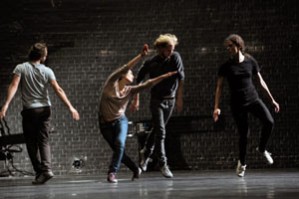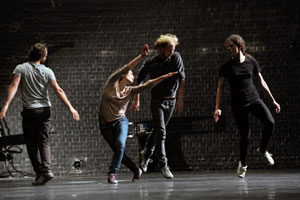

L. Ch̩touane Р15 Variations on Openness
premiered at the HAU, Berlin, 30./31. August 2013
Being open for the open – this setting for a mutual encounter of the undefined asks to allow the yet still unexplicable to approach one’s sense/bility in all its open-ended variations of possibilities, and to whatever experience it might lead. This option demands to have the sensorium, which in its interruption leads to sense, that other sense (side) of sense (Nancy), set to ‘undisrupted’ beyond the point of the usual precipitated closure on the seeming discovery of supposedly known concepts. It opens up to unforeseen experiences, but also to the task that even might be more difficult and thus scary than the encounter with not only pleasant experiences: What to do with the unknown? How to acknowledge the yet nameless? And even if the unknown can be accepted as that still in need to be defined, how after all come to knowing?
The unknown is a demanding guest. She disturbs the routines of habit, interrupts the path of making sense of habitual rupture, that, depending on the degree of fear allowed to be felt, commonly cuts short our ability of curiosity. This guest wants to have it all different, even the almost similar, feels changed – a scary task, when one has to consider all the potential options. The safe zone of supposedly ‘doing it right’ out of a sudden dissolved.
The unknown questions not only perception and thus knowing, when letting this guest really in, she might affect current ethics and demand to explore them in relation to the newly appearant, this unexplored occurrence in and of spacetimematter. Even one unkown detail might mix up all the exsisting relations, and with securities gone each movement’s ignition seems to linger and to refer to that momentary glimpse of a space of the inbetween, that occurs before interpretation and still entails a variety of options.
The choreographer Laurent Chétouane took J.-L. Nancy’s definition of an “'[o]penness’ as the limitlessness and plurality of our senses†as the point of departure for his latest piece 15 Variations on Openness. The approach, that also defines the title of the performance piece, is further outlined in the performance handout as that “[s]olidly defined truths, identities, or structures can no longer bring us together; our only hope may lie in organizing coexisting possibilities†. Each interaction and constellation among the two female and two male dancers on stage, who seem to wear their daily clothing and sneakers, creates a possible constellation of its own within the field of play. These constellations manifest themselves in space and time and are not generally interchangeable, but display one definition of a certain moment of mattering. In this interplay of relationality each part of the constellation is considered as influential, each a player within the whole, including the viewers in the audience, the stage – in this case a very empty, raw stage – and equally the ‘unplugged’ instruments and performance of the musicians.
Not that this is such an utterly new insight, but to allow this moment to occur as a tangible concept which becomes activated by the main actors, who, next to the musicians, are certainly the dancers with their search for an expression of openess in their distinctly choreographed movements. And it is the convincing part of this evening (which nevertheless took me two visits to fully understand it) that they indeed find a slender limberness, that is still directed but seems to allow the emergence of an undefined inbetween to breath just for a moment or two.
Neuroscienctific research considers motion increasingly as one, if not the basic concept of being in this world and essential for a coming to know of it. A point that certainly supports L. Chétouane’s idea to explore the not-known in the unforeseeable motion of dance moves. The concept includes the attempt to redirect the occurring (e)motional affect for all involved participants, also the audience and their openness towards this experience.
The second main aspect Chétouane bases his works on, is perception. In the case of the dancers it is a perception in motion, one that demands them to relocate their selves within the changing perception of space and equally in the eyes of the onlookers, who in turn are confronted with the motion, and the obvious awareness of being looked at created through the returned gaze of the dancers.
The opening of the view on both sides, the visibility of the participants, dancers, audience, musicians, space, allows to bring forward an open moment within the existing structure, that the set frame theater space entails. The emerging layouts of interplay, like the changing of positions, when for example one of the musicians changes his place or the dancers take up the position of viewers, either by standing at the side of the stage or directly in front of the audience, bring forward defining relationalities, that are ‘opened-up’ for ‘re-definition’ through the movements.
K. Waiss writes in his thesis “Attempt in excess of the scenic event. An approach to contemporary dance and performance in the philosophy of Jean-Luc Nancy.†after a conversation with L. Chétouane, that the activation of the inbetween as the space of the ‘unknown’ might relate to a certain form of being touche – touched in the sense of being affected that initiates a process of transmission. One that allows the emergence or better the acknowledgement of a moment of inbetween that is not yet caught in images which can be translated into representation right away.
Already in a leaflet announcement from 2009 Chétouane poses the question of how the inbetween can occur, that in terms of dance, make productively use “of this space of this “in-between“, this “not yet“, this “gone already“, of this openness, this space of the nullification of security and readability, where meaning still fluctuates and images still emerge?†It is precisely this thought that allows to build a link to concepts based on recent ideas, from independently oriented sources, which define movement prior to thought as the very form of discourse between human and as well as non-human agencies. Without directly drawing on posthumanist sources the piece references a field of thought that explores a ‘decentered’ proposition of experience which seek approaches outside of the restricted field of representational definitions.
These recent insights can be taken as an initial point for setting focus on what necessarily defines the specific movements, which obviously demand a sort of limberness, an openness, that both embeds and reveals its potentiality within the inherent options of possibilities, as emerging from an unknown horizon of yet undefined and thus frightening, and equally threatening moves. It is the undefined in the possible, the paradox between the directed and the open, the coming together of two states, which don’t exclude each other, because of the decision for a stipulated ‘know-how’.
This sort of experimentation became already apparent in Chétouane’s piece ‘Sacré Sacre du Printemps’ in 2012, where his choreographic instructions included specific movement technics for his dancers. These advices seemed to have been based on ‘measuring’ the location in space through perception that enacts movement, and in return eventually enabled to act in a ‘non-representative’ in-between state. For the choreographer L. Chétouane the emergence of this quasi ‘imperceptible no-space‘ of the inbetween has to be re-negotiated at each moment in space – between the performers, between performer and audience and as well as for simply being in the space.
15 Variations about Openess is again an experiment that explores distance and proximity, visual and physical encounters, the inversion of outside and the inside (visible also in the raw stage design) on stage and as well in its interaction with the view of the audience. It certainly brings forward a gentle challenge to be open for the open, not only for the choreographer and the dancers, as laid out the program, but equally prompting the audience to become part of this process of thought/movement.
Four dancers, accompanied by live music by Nico Muhly, an American composer, develop constellations that simultaneously spatialize a variety of possibilities while doing away with security based on the permanent, in order to explore the unknown encounters formed by a ‘with’ that takes place in the liminal space outside each of their four bodies. What does choreography mean? How do you choreograph uncertainty? How can a choreographer be so ‘open’ that his form or technique does not develop into an identity or language, and yet simultaneously create a space in which his performers can (once again) think and dance togetherness? (from program leaflet)
The result is a distilled essence of a very slender and light fragrance that needed me to watch it more than once to be able to get the full taste of it, a taste that far from being arbitrate allowed a sense of ease and playfulness to emerge from the gap of e/ motions despite being seated in a fixed position.
from the program information:
Laurent Chétouane (FR | D) 15 Variationen über das Offene
Philosopher Jean-Luc Nancy defines ‘Openness’ as the limitlessness and plurality of our senses. Solidly defined truths, identities, or structures can no longer bring us together; our only hope may lie in organizing coexisting possibilities. This idea formed a departure point for the piece “15 Variations on Openness,†the second part of Laurent Chétouane’s togetherness trilogy. Four dancers, accompanied by live music by Nico Muhly, an American composer, develop constellations that simultaneously spatialize a variety of possibilities while doing away with security based on the permanent, in order to explore the unknown encounters formed by a ‘with’ that takes place in the liminal space outside each of their four bodies. What does choreography mean? How do you choreograph uncertainty? How can a choreographer be so ‘open’ that his form or technique does not develop into an identity or language, and yet simultaneously create a space in which his performers can (once again) think and dance togetherness?
Choreography Laurent Chétouane
With Matthieu Burner, Mikael Marklund, Senem Gökce Ogultekin, Sigal Zouk
Music Emmanuelle Bernard, Mathias Halvorsen, Michael Rauter
Composition Nico Muhly
Music direction Michael Rauter
Dramaturgy Leonie Otto
Costume Sophie Reble
Light Stefan Riccius
Production 15 Variationen über das Offene GbR
Co-production Tanzquartier Wien, Les Subsistances (Lyon), PACT Zollverein (Essen), HAU Hebbel am Ufer (Berlin)
Funded by Basisförderung Berlin/Regierender Bürgermeister von Berlin – Senatskanzlei – Kulturelle Angelegenheiten, Fonds Darstellende Künste e.V., 3-jährige Konzeptionsförderung aus Mitteln des Bundes
Supported by Dock11/*****Eden Berlin
